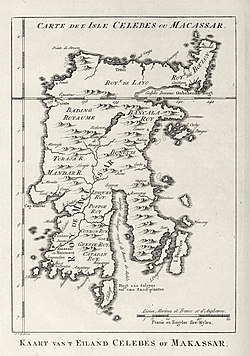User:Han4299/sandbox
Sultanate of Makassar 𑻥𑻠𑻰𑻭 (Makasar) | |||||||||||||
|---|---|---|---|---|---|---|---|---|---|---|---|---|---|
| 1528–1667 | |||||||||||||
|
Flag | |||||||||||||
| Motto: Rua karaeng na seqre ata (Makasar) "Dual kings with one people" | |||||||||||||
 | |||||||||||||
| Status | Dissolved | ||||||||||||
| Capital | Tamalate (1528–1548) Somba Opu (1548–1667) | ||||||||||||
| Common languages | Makassarese | ||||||||||||
| Religion | Animism prior to c.1605 Sunni Islam after 1605 | ||||||||||||
| Government | Monarchy | ||||||||||||
| Sombaya (Monarch) (Gowa dynasty) | |||||||||||||
• 1528-1546 | Tumapaqrisiq Kallonna | ||||||||||||
• 1639-1653 | Sultan Malikussaid | ||||||||||||
• 1653-1669 | Sultan Hasanuddin | ||||||||||||
| Tumaqbicara Butta (Prime Minister) (Talloq dynasty) | |||||||||||||
• 1528-1543 | Karaeng Tunipasuru | ||||||||||||
• 1593–1623 | Sultan Abdullah Awalul Islam, Karaeng Matoayya | ||||||||||||
• 1654–1667 | Sultan Harun Al Rasyid | ||||||||||||
| History | |||||||||||||
• Established | 1528 | ||||||||||||
| 1667 | |||||||||||||
| Currency | jinggaraʼ | ||||||||||||
| |||||||||||||
| History of Indonesia |
|---|
 |
| Timeline |
|
|
Kingdom of Makassar
History[edit]
Before the establishment of the kingdom, the region had been known as Makassar and its people as Suku Makassar (tribe of Makassar).[1] The history of the kingdom can be divided into two eras: pre-Islamic kingdom and post-Islamic sultanate.
Before Unification[edit]
According to the epic poem The Nagarakretagama, in praise of King Rajasanagara of Majapahit, it lists Makassar as one of the kingdom's tributaries in 1365.[2]
The first queen of Gowa was Tomanurung Baine.[1] There is not much known about the exact time when the kingdom was established nor about the first queen, and only during the ruling of the 6th king, Tonatangka Kopi, local sources have noted about the division of the kingdom into two new kingdoms led by two Kopi's sons: Kingdom of Gowa led by Batara Gowa as its 7th king covering areas of Paccelekang, Pattalasang, Bontomanai Ilau, Bontomanai 'Iraya, Tombolo and Mangasa while the other son, Karaeng Loe ri Sero, led a new kingdom called Tallo which includes areas of Saumata, Pannampu, Moncong Loe, and Parang Loe.[1]
For years both kingdoms were involved in wars until the kingdom of Tallo was defeated. During the reign of King of Gowa X, I Manriwagau Daeng Bonto Karaeng Lakiung Tunipalangga Ulaweng (1512-1546), the two kingdoms were reunified to become twin kingdoms under a deal called Rua Kareng se're ata (dual kings, single people in Makassarese) and enforced with a binding treaty.[1] Since then, when someone becomes a king of Tallo, he also becomes the king of Gowa. Many historians then simply call these Gowa-Tallo twin kingdoms as Makassar.[1]

Islamic Sultanate[edit]
The traces of Islam in South Sulawesi existed since the 1320s with the arrival of the first Sayyid in South Sulawesi, namely Sayyid Jamaluddin al-Akbar Al-Husaini, who is the grandfather of Wali Songo.[3]
The conversion of the kingdom to Islam is dated as September 22, 1605 when the 14th king of Tallo-Gowa kingdom, Karaeng Matowaya Tumamenaga Ri Agamanna, converted to Islam,[4] where later changed his name to Sultan Alauddin. He ruled the kingdom from 1591 to 1629. His conversion to Islam is associated with the arrival of three ulama from Minangkabau: Datuk Ri Bandang, Datuk Ri Tiro and Datuk Ri Pattimang.[5]
From 1630 until the early twentieth century, Gowa's political leaders and Islamic functionaries were both recruited from the ranks of the nobility.[4] Since 1607, sultans of Makassar established a policy of welcoming all foreign traders.[2] In 1613, an English factory built in Makassar. This began the hostilities of English-Dutch against Makassar.[2]
The most famous Sultan of the kingdom was Sultan Hasanuddin, who from 1666 to 1669 started a war known as Makassar War against the Dutch East India Company (VOC) which was assisted by the prince of Bone kingdom of Bugis dynasty, Arung Palakka.[6]
Test 2[edit]
| This is the sandbox page for User:Han4299. |
- ^ a b c d e Sewang, Ahmad M. (2005). Islamisasi Kerajaan Gowa: abad XVI sampai abad XVII (in Indonesian). Yayasan Obor Indonesia. ISBN 978-9-794615300.
- ^ a b c "MAKASSAR". Retrieved March 4, 2016.
- ^ Hannapia, Muhammad Ali (2012). "Masuknya Islam di Gowa". muhalihannapia.blogspot.com (in Indonesian).
- ^ a b Hefner, Robert W.; Horvatich, Patricia (1997). Robert W. Hefner; Patricia Horvatich (eds.). Islam in an Era of Nation-States: Politics and Religious Renewal in Muslim Southeast Asia. University of Hawaii Press. ISBN 978-0-824819576.
- ^ SILA, MUHAMMAD ADLIN (2015), "The Lontara':: The Bugis-Makassar Manuscripts and their Histories", Maudu’, A Way of Union with God, ANU Press, pp. 27–40, ISBN 978-1-925022-70-4, retrieved 2021-05-31
- ^ Ricklefs, M.C. (2008). A History of Modern Indonesia Since C.1200 (revised ed.). Palgrave Macmillan. ISBN 978-1-137052018.


